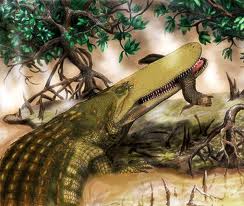A new prehistoric croc sporting an odd head “shield” has been found in Morocco, according to a study published .
Dubbed ShieldCroc, the animal’s head appendage was surrounded by blood vessels and covered with a sheath like those seen in frilled dinosaurs, including Triceratops.
At 30 to 35 feet (9 to 11 meters) long, the river-dwelling monster would have preyed on other giant animals of the late Cretaceous, such as 13-foot-long (4-meter-long) Coelacanths. But ShieldCroc—formally Aegisuchus witmeri—likely boasted relatively weak jaws, at least compared with those of today’s crocodiles.
“It’s fairly certain that it belonged to a group of crocodyliforms—including the flat-headed crocs—that had really thin, weak jaws and weak chin joints,” said researcher Casey Holliday, a paleontologist at the University of Missouri. Crocodyliforms are part of a group known as the crocodilians, which includes modern-day alligators, caimans, and more.
“So they weren’t wrestling dinosaurs on the water’s edge. They would have been quick, snap feeders waiting for prey to come by and then grabbing it and swallowing it with large, basket-shaped mouths—something like a pelican would do,” said Holliday, who co-authored the new study in the journal PLoS ONE.
ShieldCroc’s Headpiece for Show?
A piece of ShieldCroc’s skull landed in Canada’s Royal Ontario Museum in the early 2000s, but Holliday and colleagues have only recently studied the specimen and its odd headpiece.
It’s difficult to determine what purpose the shield served when the animal lived, some 99 million years ago, Holliday noted.
But after rigorous evaluation of the fossil and studies of comparative behaviors with modern crocodilians, scientists suggest the shield may have helped ShieldCroc regulate its temperature and communicate with other ShieldCrocs.
For instance, some crocodyliforms and living crocodilians, such as the Cuban crocodile, have horns on the sides of their heads, which males use to impress females and scare away other males. “We kind of see ShieldCroc having similar behaviors and showing off the roof of its head,” Holliday said.
Despite these possible similarities with modern crocodilians, the animal appears to have been one of a kind, said Christopher Brochu, a University of Iowa paleontologist, who wasn’t involved in the study.
“There’s nothing quite like this among the birds or the crocodilians, which are the two closest living relatives of this thing.”
ShieldCroc Highlights African “Melting Pot”
ShieldCroc’s discovery in Morocco could suggest that modern crocs evolved in what’s now the Mediterranean—a theory that remains hotly debated among crocodilian experts.
But there’s no doubt the animal provides evidence of astonishing crocodyliform diversity in the Southern Hemisphere during the late Cretaceous, said Holliday, who described the new species this week at the 71st Annual Meeting of the Society of Vertebrate Paleontology in Las Vegas.
“It definitely points to … Africa [as] a melting pot of different crocodyliforms living in the same region at the same time,” Holliday said.
“One lineage, including DogCroc, BoarCroc, and others tended to be terrestrial, while another group, including SuperCroc, were big, aquatic, predatory crocs. ShieldCroc represents another group and a more modern flavor of crocs.”
Bizarre Crocodyliforms Ruled Southern Hemisphere
With the discoveries of ShieldCroc and related species, University of Iowa’s Brochu said, “We’re beginning to realize just how diverse and even bizarre the crocodilyforms were in the Southern Hemisphere,” he said.
“The group was extremely widespread, and in some places crocodyliforms may have been among the major predators and even herbivores. And in some places they really were simply bizarre.”
For instance, “in the southern Mediterranean, including North Africa, we’re seeing these animals that look nothing like any living crocodilian.”



 August 27th, 2012
August 27th, 2012  riffin
riffin 
 Posted in
Posted in  Tags:
Tags: 